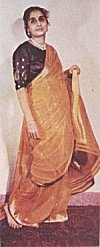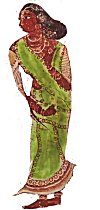The Story of the Saree
The Story of the Saree
by Jyotsna Kamat
First Online: June 15, 2000
Last Updated: December 07, 2024
The Indian Saree (a.k.a. Sari, Seere, Sadi) boasts of oldest existence in the sartorial world. It is more than 5000 years old! It is mentioned in Vedas, the oldest existing (surviving) literature (3000 B.C.) Patterns of dress change throughout the world now and then but, the Sari has survived because it is the main wear of rural India. 75% of the population (now a billion as per official estimate) wear versatile sari. We can certainly call this cloth versatile because it could be worn as shorts, trousers, flowing gown-like or convenient skirt-wise--all without a single stitch!
Saree (original--Chira in Sanskrit, cloth) is of varied length. From 5 yards to 9.5 yards tied loosely, folded and pleated, it could be turned into working dress or party-wear with manual skill. For day today dress of middle class women, 5-6 yard sari is comfortable to manage household chores. Working class tucks the same length above the ankles and if they have to work in water or fields, they would tuck the front pleats between the legs to the back, and tie the upper portion round the waist. This left them free movement of hands and legs.
|
|
|
|
One Saree. Many Incarnations |
|
A nine yard saree used to be a connoisseurs pleasure with embellishments, embroidery and gold designing. At the same time it was as safe a dress as trousers. It was worn in the similar way as working saree. But, some pleats covered the ankles as well. A gold silver or cloth belt was fastened which kept pallu, (upper cover) pleats and folds in tact. Jhansi's Queen Laxmibai, Belawadi Mallamma and Kittur Chennamma fought enemy troops on horseback, wearing saree this way. Tight tucking of the front pleats in the back was called Veeragacche or soldier's tuck.
Generally the climate of Indian subcontinent is warm and humid. Saree and its male counterpart dhoti was most suited for this land. Earlier there was hardly any difference between Saree and dhoti because men also liked to flaunt colorful Sarees with brocaded borders (see: Sarees for Men!). They could perhaps be interchanged in needy times. Only the upper portion of the saree-length which covers the chest, left shoulder and at times head, is missing in saree for men.
Styles in wearing saree vary from region to region. Gujarat style and Bengali style are different. So are Mangalorean, Kannadiga, Kodava, Tamilian, Malayali, etc. The Saree is worn in at least 10 to 15 styles throughout the India, though the ways of wearing above used to be common. In Maharashtra and North Karnataka region, wearing a nine yard saree (without a petticoat -- long underskirt --which was superfluous) was in vogue till 20th century. My mother who was a good swimmer, used to wear a nine yard saree tightly and swam in Kali river or Arabian sea along with my father. Wearing swimming costume could just not be dreamt of. But the versatile saree was good enough to move through the waves.
Some people think that Indian saree is influenced by Greek or Roman toga which we see on ancient statues. This is not correct. Saree is essentially Indian and designed to suit local conditions. Cotton was cultivated in India centuries before Alexander the Great landed on the borders of India and Indian cloth (chira or Saree) was a wonder to Greek eyes. In fact, Herodotus and other ancient western historians thought there were cloth-growing trees in India!
Raja Ravi Varma, the distinguished painter of 19th century, toured the entire sub-continent in search of the ideal female-wear. He wanted the best dress for the various goddesses he was asked and commissioned to paint. He selected the a nine yard saree which drapes the body beautifully at the same time exhibiting contours of female anatomy--bust, waist, hips. Most of the female deities he painted are in this style.
|
|
Woman Wearing Saree |
An old or worn-out saree is equally utilitarian. Grandmothers used to stitch quilts folding soft and worn-out Sarees and putting bright new cloth on cover, for children which kept them warm. Worn-out thicker Sarees were used as bed covers or blankets in the cradle (as the babies wetted it frequently). For village women, folds of Sarees serve as pouches, bags and haversack to carry grocery and at times babies as well. Some used to make a stand-by cradle out of sree length for the baby. Tying the ends to a nearby tree. White Sarees could be turned into towels, napkins, diapers etc., even after they are worn out.
Dhoti is an abridged version of the saree sans pallu (the throw of the saree). Many Hero-stones (memorials for dead heroes) show the dhoti worn like breeches or shorts with Veeragachche; dagger and other weapons were tucked in dhoti folds.
With globalization, the dress of Indians is also getting westernized. But being most utilitarian, and multi-purpose saree is still reigning in rural India and for all rituals and ceremonials it shines supreme to this day. Colorful sarees are worn as pugrees, turbans and tribals flaunt invariably women's sarees in dances. Yakshagana dancers wear saree designed clothes.
![]()
See Also:
- Topics on Ancient India at Kamat's Potpourri
- Topics on Medieval India at Kamat's Potpourri
- Kamat Saree Sapne -- Online Exhibition of Various incarnation of the Saree
- How to buy a Saree -- or why buying a Saree is difficult
- Sarees for Men -- will reverting to a unisex attire equate the fields for women?!
- Men's Head-Gear in India -- an equally fascinating exhibition on the caps and turbans of India




